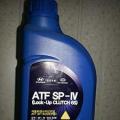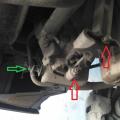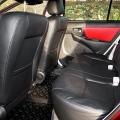Chery Bonus debuted in 2008 and entered the domestic market in 2011. It was based on the thoroughly modernized platform of its predecessor - Amulet. The assembly of the model was carried out on a full cycle in Ukraine, at the Zaporozhye Automobile Plant. There the Chinese is known as ZAZ Forza.
The Bonus body shape is similar to the sedan, but like the Amulet, it is actually a liftback. The designers from the Italian studio Torino Design were responsible for the design. The novelty was shorter than its predecessor, but it became taller and wider. The wheelbase has also increased. As a result, the passenger compartment has more space for front and rear passengers.
In 2011, a hatchback version was offered, which was named Very. Due to the shorter stern, the car lost 13 cm in length. The rest of the dimensions are identical.
Base models were equipped with air conditioning, central locking and a driver's airbag. An MP3 audio system, a front passenger airbag, heated seats and ABS were all available in a more expensive package. The top version featured 15-inch alloy wheels and parking sensors.
Engine
Cherie Bonus relied on only one power unit - a four-cylinder gasoline aspirated with a volume of 1.5 liters and a return of 109 hp. The 16-valve engine of the Acteco SQR477F family is a product of a joint development of the Chinese and the Austrian company AVL. The engines were assembled on the territory of Ukraine - in Melitopol.
The motor has one camshaft and hydraulic valve clearance compensators. The gas distribution mechanism is driven by a toothed belt. The manufacturer prescribes its renewal every 40,000 km. However, the belt often breaks, never having reached the next routine maintenance. In this case, kinking of the valves is inevitable. The main reason is a large number of fakes and low-quality analogs. They sometimes surrender after 10-20 thousand km.
With the help of a timing belt, the pump is also driven. It can make noise or flow through 40-60 thousand km. It is not worth delaying the replacement. Over time, the pump begins to wedge, which leads to slipping of the timing belt or even to its breakage. There are precedents. The cost of the original pump is about 1,000 rubles, but high-quality analogs last longer (from 1,500 rubles).
In the cold season, owners often complain that the engine has difficulty starting or stalls during warm-up. Sometimes it is possible to get rid of the problem after replacing the adsorber valve (600 rubles). But most likely, the reason lies in an unsuccessful engine management program.
After 40-90 thousand km, you have to change the support of the power unit (1-2 thousand rubles). The most vulnerable is the front. In addition, the thermostat (300 rubles), ignition coils (2-3 thousand rubles) and oxygen sensors (1.5-2 thousand rubles) are being updated. Subsequently, the starter and generator have to be repaired. A new node is available for 5-6 thousand rubles.
Transmission
The engine is paired with a 5-speed manual transmission. Unfortunately, the box often requires repair for another 50-100 thousand km. Most often it is necessary to change the bearings of the input and output shaft. But the list may include 1st and 2nd gear synchronizers, 2nd gear, or differential bearings. The cost of repairs will be at least 10,000 rubles.
The factory clutch may require replacement after 50-70 thousand km. The new original will last the same amount. Substitutes from renowned manufacturers (in particular Valeo) have a higher resource. A set of a good analogue will cost 10,000 rubles. The original clutch basket and release bearing can fail before time.
From time to time, CV joints also fall into the spotlight: external and internal (1-2 thousand rubles per hinge).
Chassis
The suspension scheme, in comparison with the Amulet, has not changed: MacPherson struts at the front and a semi-independent beam at the rear. However, the geometry is different: the wheelbase and front track have increased.
The most vulnerable elements are rear shock absorbers (1-2 thousand rubles). They could have flowed after 20-50 thousand km. The front ones (2-2.5 thousand rubles) served more than 40-70 thousand km.
After 50-100 thousand km, it is the turn of the silent blocks of the front levers and the rear beam (150-300 rubles apiece).
Wheel bearings often give up after 20-70 thousand km. The front ones change separately (2,000 rubles for bearings), and the rear ones are assembled with a hub (1.5-2 thousand rubles per hub).
The steering rack could knock after several thousand kilometers. And it is often necessary to sort it out after 60-80 thousand km (it starts to rattle or leak). A repair kit is available for 3,000 rubles, and a new rail for 16,000 rubles.
The power steering pump may also require attention - the bearings wear out prematurely. The cost of the original pump is about 3,000 rubles.
Body and interior
Unfortunately, after 4-6 years, no, no, and even foci of corrosion are found. Most often, rust affects the rear wheel arches, less often sills.
The interior looks rustic and materials seem cheap. Crickets often settle in the cabin, and locks often knock on the doors.
After 4-5 years of operation, some owners are faced with a breakdown of the driver's visor - the bracket and plastic fasteners are destroyed. Seat heating also does not differ in durability.
Many Bonus holders found water at the feet of the front passenger. It entered the passenger compartment through a poorly glued windshield or a clip located under the windshield above the cabin filter (under the frill).
In the future, the wiper begins to be capricious. Most often, the reason lies in the failed motor of the electric drive. Sooner or later, limit switches also fail in the door and trunk locks. The limit switches can be replaced with new ones.
Conclusion
Chery Bonus (Very) cannot boast of exemplary reliability. The situation was sometimes aggravated by the poor build quality, and the resource of original spare parts was too small. A large amount of counterfeit products in the spare parts market also contributes. Fortunately, until it comes to overhaul of the engine, and troubleshooting does not require large financial costs.
Replacing the valves with the Cherie Bonus (A13) is done when the valves are bent or they are burnt out. This work also needs to be done in case of wear of the "leg". If you are not a minder, then it is almost impossible to do it yourself.
The work of replacing valves with Chery Bonus (A13) is done by removing the cylinder head (cylinder head). At a minimum, you will need a cylinder head gasket, a valve cover gasket, intake and exhaust manifold gaskets. If necessary, we can make replacement of the guides (saddles).
Cost:
Car service in St. Petersburg:
* - on the removed cylinder head
** - depending on the presence of washers, "glasses" and the possibility of adjustment
*** - depends on engine size
ATTENTION!!! We do not work on cylinder heads removed by ourselves. We ourselves remove the cylinder head on the car, and do all the necessary procedures.
When to replace:
- one or more valves are burnt out;
- the valve is "bent";
- increased oil consumption in the engine;
Warranty - 180 days.
In our store, you can purchase spare parts.
nice girl in a small Chinese car. So, we meet Chery Bonus, replacing the timing belt, pump and auxiliary unit belts. On the speedometer 45,000, since the replacement interval is 50,000, we recommend replacing the pump as well, since it is unlikely that the old one will reach one hundred thousand.
Replacing the timing belt on this engine will not be particularly difficult, the only caveat is the belt tension, since the tension roller does not have a tension mechanism. Here Russian ingenuity will help us, but more on that later in the article.
So, under the hood is a 1.5-liter engine with Cherie's logo.
First, remove the front right wheel and engine protection. We drain the antifreeze by removing the lower pipe. Then we loosen the nut and the power steering bolt (red arrows) and unscrew the tensioning bolt (green arrow) to the maximum. Remove the power steering belt.

Using a suitable open-end wrench, turn it counterclockwise using a special protrusion on the tension roller, thereby loosening the tension on the alternator belt. Remove the belt.

We unscrew the crankshaft pulley bolt. If you perform this procedure with a partner, then he gets into the car, turns on the fifth gear and presses on the brake with all his might. And at this time you pull off the bolt with a slight movement of your hand. If you are working alone, then you install supports under the wheels, turn on the fifth gear, tighten the handbrake. Insert a screwdriver into the brake disc of the front right wheel, so that it rests on the caliper, and rip off the bolt.


And the bottom one is also attached with two bolts.

We expose the top dead center. To do this, temporarily screw in the crankshaft bolt, turn off the speed and necessarily clockwise turn the crankshaft until the marks coincide and the inscription FRONT appears at the top.

The mark on the camshaft sprockets should also coincide. It is not very convenient to look there.


And then right.

We remove the old timing belt and the roller itself. Next, unscrew the pump, four bolts by six. We must substitute the container, since there is still a little antifreeze left in the engine.

Let's start assembling

We install the pump and tension roller in place, do not tighten the roller fastening. We check all the labels. We put on the timing belt from the beginning to the crankshaft sprocket, pump, camshaft sprocket and tension roller.
When installing the timing belt, do not forget about the direction of rotation.
And now the fun part is how to tighten the belt. We used a long, bent pry bar to push it against the lip of the oil pump and push against the roller. I read somewhere that people do the same thing only from below, resting the mount against the engine bracket, in principle, this is not important.

After tightening the belt, we collect everything in the reverse order of removal. Everything about everything took an hour and a half with a smoke break.
Good luck on the road. Not a nail, not a rod!




